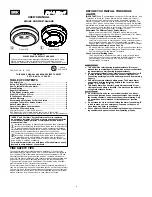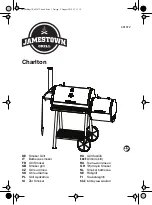
CAUTION: Do not overtighten the screws.
[4] Sampling Tube Installation for Ducts Greater Than 1
1
⁄
2
Feet
Wide
The sampling tube is identified by a series of air inlet holes on the tube.
A plastic tube is included for ducts up to 1
1
⁄
2
feet wide. All other lengths
must be purchased separately. Order the correct length, as specified in
Table 1, for width of the duct where it will be installed. It is recommended
that the sampling tube length extend at least
2
⁄
3
across the duct width for
optimal performance. The exhaust tube is molded onto the base of the
duct housing, and the A2440-00 Exhaust Tube Extension is available as
an accessory in those cases where the molded exhaust port does not
extend at least 2 inches into the duct.
The sampling tube is always installed with the air inlet holes facing into
the air flow. To assist proper installation, the tube’s mounting flange is
marked with an arrow. Make sure the sampling tube is mounted so that
the arrow points into the air flow (see Figure 4). Figure 5 shows the
various combinations of tube mounting configurations with respect to air
flow. Mounting the detector housing in a vertical orientation is acceptable,
provided that a metal sampling tube is used and the air flows directly into
the sampling tube holes as indicated in Figure 4.
[4.1] Installation For Ducts Greater Than 1
1
⁄
2
Feet But Less Than 8
Feet Wide
1.
If the tube is longer than the width of the air duct,
drill a
3
⁄
4
″
hole in the
duct opposite the hole already cut for the sampling tube. Make sure the
hole is 1
″
to 2
″
below the inlet hole on the opposite side of the duct to
allow moisture drainage away from the detector.
If the tube is shorter
than the width of the air duct,
install the end cap into the sampling
tube as shown in Figure 4. Sampling tubes over 3 ft. long must be
supported at the end opposite the duct smoke detector.
2. Slide the tube into the housing bushing that meets the air flow first.
Position the tube so that the arrow points into the air flow, as shown
in Figure 4.
3. Secure the tube flange to the housing bushing with two #6 self-tapping
screws.
4. For tubes longer than the width of the air duct, the tube should extend
out of the opposite side of the duct. If there are more than 2 holes in
the section of the tube extending out of the duct, select a different
length using Table 1. Otherwise, trim the end of the tube protruding
through the duct so that 1
″
to 2
″
of the tube extend outside the duct.
Plug this end with the end cap and tape closed any holes in the pro-
truding section of the tube. Be sure to seal the duct where the tube
protrudes.
NOTE:
The sampling tube end cap is critical to the proper operation of
the duct smoke detectors. The end cap is needed to create the
proper air flow to the sensor of the duct smoke detector
.
J500-41-00
3
I56-2199-003R
SCREW HOLES FOR
ATTACHING HOUSING
TO DUCT WORK.
Figure 3. Installation of foam gaskets over sampling
tube bushings:
Figure 5. Tube mounting configurations with varying
air flow direction:
Table 1. Sampling tubes recommended for different
duct widths:
Outside Duct Width
Sampling Tube Recommended*
1 to 2 ft. (0.3 to 0.6 m)
ST-1.5
2 to 4 ft. (0.6 to 1.2 m)
ST-3
4 to 8 ft. (1.2 to 2.4 m)
ST-5
8 to 12 ft. (2.4 to 3.7 m)
ST-10
*Must extend a minimum of
2
⁄
3
the duct width
SAMPLING
TUBE
END CAP
AIR HOLES
ARROW
MUST FACE
INTO AIR FLOW
AIR FLOW DIRECTION
FLANGE
Figure 4. Air duct detector sampling tube:
AIR FLOW
DIRECTION
DETECTOR
HOUSING
DOTS INDICATE POSITION OF
SAMPLING TUBE HOLES
AIR FLOW
DIRECTION
DETECTOR
HOUSING
SAMPLING
TUBE
EXHAUST
TUBE
AIR FLOW
DIRECTION
EXHAUST
TUBE
SAMPLING
TUBE
SAMPLING
TUBE
EXHAUST
TUBE
DETECTOR
HOUSING
AIR FLOW
DIRECTION
DETECTOR
HOUSING
A.
B.
C.
D.
HORIZONTAL MOUNTING OF HOUSING
VERTICAL MOUNTING OF HOUSING
NOTE: Only metal sampling tubes can be installed in
orientations C and D.
H0107-00
H0108-02
H0109-00
H0109-01


























